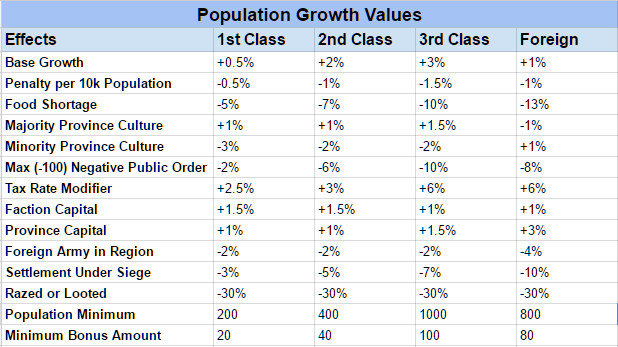Population System Guide
Overview
The general concept of the Population System in Divide et Impera is to require certain population classes for armies to recruit units in a region. These population levels will grow over time depending on various conditions. Different unit types will require different types of population and a culture will have to grow its population over time in newly conquered regions.
Population Classes
- Upper Class (Partricians/Nobles)
- Middle Class (Plebians/Warrior Class)
- Lower Class (Proletarii/Commoners)
- Foreigners
Total population and starting population reflect a ratio of the general levels of population at the time for specific regions in terms of males at fighting age. You can see the population of a region and the growth factors by hovering over the population icons in the top right of the region panel. You can also see the total population under those icons.
When you recruit a unit, it will have its population class and amount listed as the cost of recruitment. You can also see the class, type and total manpower of any unit in your armies by hovering over that unit.
Population Growth
Population growth is influenced by a variety of in-game factors. These factors vary based on population class and include:
- Base Growth: Each region’s base growth is dependent on the ratio of the total population to the population of a specific class. As that class’ population increases, it will get increasing negatives based on the “Penalty per 10k Population” value seen below.
- Building Modifiers: Various buildings give bonuses to specific class growth, depending on the building type. These values are halved when your faction does not have the majority culture.
- Food: Food shortages for your faction give a huge negative to population growth, while having a surplus will give a positive.
- Majority Culture: Having the majority culture in your area will increase growth, while having the minority will decrease it (opposite for foreigners)
- Public Order: As public order decreases, so does growth.
- Taxation: High taxes for your faction will decrease growth and vice versa. The amount each class is affected is based on the “Tax Rate Modifier” seen in the table below.
- Faction and Province Capitals: Receive specific bonuses to growth values.
- Foreign Armies and Under Siege: The presence of a foreign army in the region will decrease growth and a settlement under siege is decreased even further.
- Looted or Razed Settlement: A very large penalty to growth results from a settlement that has been looted or razed.
- Minimum Bonus: If a certain class falls below a specific amount, it will get a bonus amount added each turn until it gets back above the minimum amount.
Foreign Population Mechanic
- When you conquer a region, all it’s population will be converted to Foreigners and you will have to build your citizen populations up from scratch in the region. If you have majority culture in that province, you will get half the population back rather than all foreigners.
- If the total foreigner population of your faction gets above 50% then it will cause public order penalty in all your regions. The greater the total % of foreigners in the faction the worse the public order will be.
- The % of foreigners in any given region will determine the level of administrative control over the region represented by a modifier to subsistence income. There are 4 stages of this to represent different types of regions: Heartland, Provincial, Colonial, Subject. At the start of a game most regions will have very small foreign populations.
Economic Effects
- There is an ideal class %: Noble = 5%, Middle = 15%, Low = 80%.
- The noble’s % determines the management of the rural areas and gives a buff or debuff to agriculture income depending on if it is higher or lower than the ideal %.
- The middle class % determines the cultural, industrial and commercial buff or debuff.
Mercenaries and Area of Recruitment Troops
- Mercenaries and AOR troops work a bit differently to how other units are recruited. These units are broken up into multiple cultural groups depending on the culture of the unit.
- If a faction recruits a Mercenary or AOR unit from their culture group, the faction will use the population class of that unit (1-3). However, if that unit is not from the faction’s culture group, it will use the population from the foreign class (4).
Replenishment
- On capturing a settlement, replenishment in that region will be disabled for that turn as there are no citizens in the region to recruit.
- In all other circumstances, the replenishment of units will draw from the appropriate population class.
- If there are not enough people of a certain class in the region to fill even one of your units, then the army will not be able to replenish and you will be forced to return to a better populated region.


